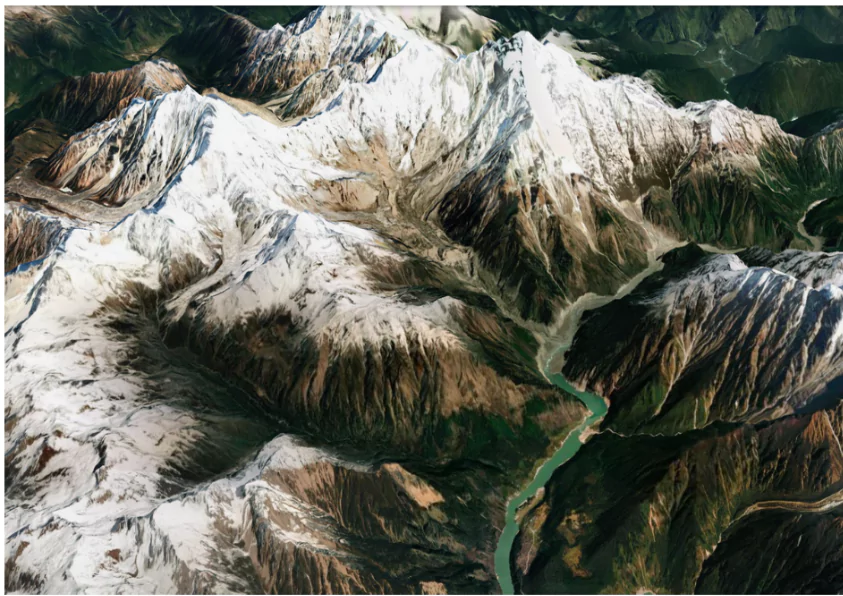A new study highlights an increase in mass wasting events (landslides and erosion) in the Sedongpu Gully, Tibetan Plateau, since 2017.
About Sedongpu Gully
- The Sedongpu Gully is situated in the catchment area of the Sedongpu glacier and valley.
- Drainage: It flows into the Yarlung Zangbo (Tsangpo) River, near the Great Bend — a significant geographical feature.
- The gully is a major source of debris flow into the Yarlung Tsangbo River.
- Great Bend: Located near the Tibet-Arunachal Pradesh border, this bend forms one of the deepest gorges on Earth, extending 505 km in length and 6,009 metres in depth.
Enroll now for UPSC Online Course
- Upcoming Project: China plans to develop a 60-gigawatt hydropower project on the Tsangpo River.
- This project will be three times larger in capacity than the Three Gorges Dam on the Yangtze River, which is the world’s largest hydropower plant.
|
- Downstream Flow: The Tsangpo River becomes the Siang River in Arunachal Pradesh and eventually joins the Dibang and Lohit rivers to form the Brahmaputra, which further flows into Bangladesh as the Jamuna.
 Environmental Conditions and Implications
Environmental Conditions and Implications-
- Bedrock Composition: The Sedongpu basin’s bedrock primarily consists of Proterozoic marble.
- Temperature Trends:
- Historical Temperatures: Before 2012, land surface temperatures ranged from -5º to -15º C, rarely exceeding 0º C.
- Recent Warming: Between 1981 and 2018, the annual temperature in nearby weather stations at Bomi and Linzhi increased at a rate of 0.34º to 0.36º C per year, exceeding the global average.
What is Mass Wasting?
- It is a general term for the movement of rock or soil down slopes driven by gravity.
- Unlike erosion by water, wind, or ice, mass wasting does not involve debris being carried by a moving medium.
- Types of Mass Wasting
- Creep: Slow, gradual movement of soil and rock down a slope.
- Solifluction: The slow, downhill flow of water-saturated soil, often in permafrost regions.
- Rockfalls: Rapid descent of rocks from a cliff or steep slope.
- Debris Flows: Fast-moving mixtures of water, soil, and rock that flow downhill.
- Landslides: Sudden and fast movement of a large mass of rock or soil down a slope.
- Occurrence
- Earth and Beyond: Mass wasting can occur on various planetary bodies including Earth, Mars, Venus, and Jupiter’s moon Io, among others.
- It involves vertical downward movement with minimal horizontal displacement, unlike slope movement.
- Mitigation Measures
- Slope Stabilization : Use of retaining walls, terracing, and grading to reduce slope angle and stability issues.
- Construction of Barriers : Erect barriers such as retaining walls or rockfall nets to stop or deflect falling debris.
- Afforestation: Plant vegetation to strengthen soil with root systems, reduce erosion, and stabilize slopes.
- It enhances soil structure and reduces water runoff.
- Improved Drainage
- Drainage Systems: Install proper drainage to manage water flow and prevent waterlogging that can trigger mass wasting.
- Methods: Use of drains, culverts, and channels to direct water away from vulnerable areas.
- Monitoring and Early Warning : Implement systems for monitoring slope stability and detecting early signs of movement.
- Engineering Solutions: Strengthen structures like roadways and pipelines against deformation caused by gradual mass wasting.
By employing these measures, the impact of mass wasting can be significantly reduced, protecting infrastructure and reducing risks to human safety.
Check Out UPSC CSE Books From PW Store
Key Findings from the Sedongpu Study
- Increasing Frequency: The study found a significant increase in mass wasting events since 2017, with over 700 million cubic metres of debris mobilised.
- Large-Scale Events: These events included ice-rock avalanches, ice-moraine avalanches, and glacier debris flows, resulting in the mobilisation of millions of cubic metres of debris.
- Contributing Factors: Rapid warming and seismic activity have destabilised the region, leading to more frequent landslides and debris flows.
- Research Methodology: The study used satellite data from December 1969 to June 2023 to analyze landslide patterns in the Sedongpu Gully catchment.
- Types of Mass Wasting Events:
- Ice-Rock Avalanche (IRA): These events temporarily blocked the Tsangpo and its tributary, Yigong.
- Ice-Moraine Avalanche (IMA) and Glacier Debris Flow (GDF): Identified as other significant mass-wasting events.
- Consequences of Blockages:
- Flash Floods: The breaching of debris dams created by IRAs has led to catastrophic flash floods in downstream areas, such as East Siang in Arunachal Pradesh and Dhemaji district in Assam in 2000.
- Flood Triggers: These floods were triggered by the outburst of dams formed by glaciated debris and rock materials from massive landslides.
- Historical Flooding Events
- 2000 Floods: Floods in East Siang and Dhemaji were caused by the breaching of a debris dam on the Yigong River, resulting from massive landslides.
|
-
Implications for India and Bangladesh
- Brahmaputra River: The Yarlung Tsangbo becomes the Brahmaputra River as it flows into India and Bangladesh.
- Increased Sedimentation: The increased sediment load in the Yarlung Tsangbo will eventually reach the Brahmaputra, affecting its course and flow patterns
- Effects of Increased Sedimentation:
- River Braiding: Higher sediment levels could cause the river to become more braided, particularly in the Assam plains.
- Bank Erosion: Increased sedimentation may lead to more significant bank erosion.
- Flood Risks: Elevated river beds due to sedimentation can exacerbate flood hazards.
- Navigation Challenges: Sand and silt accumulation could choke river channels during the lean season, complicating navigation and impacting fishing livelihoods in Assam and Bangladesh.
Enroll now for UPSC Online Classes
India’s Strategic Measures
- Hydropower Development: India is planning to incorporate “buffers” in its proposed Arunachal Pradesh hydropower project to mitigate potential risks associated with sedimentation and downstream impacts.
- Purpose of Buffers: These buffers are intended to address concerns about the increased sedimentation in the Brahmaputra River, which could result from the ongoing environmental changes and hydropower developments upstream.
![]() 26 Aug 2024
26 Aug 2024
 Environmental Conditions and Implications
Environmental Conditions and Implications